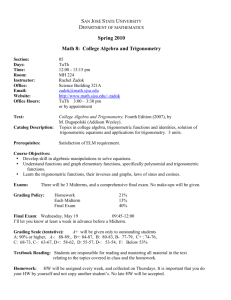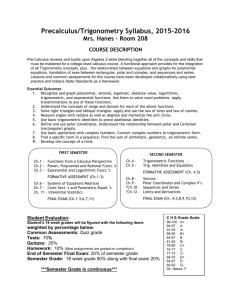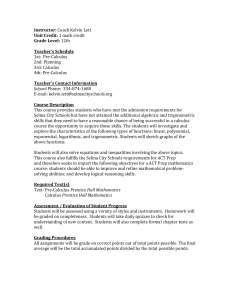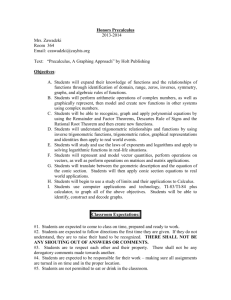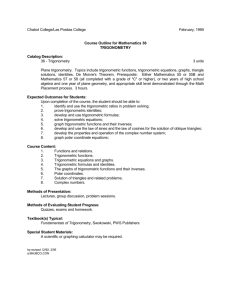Math SpringBoard Curriculum Map Precalculus Duration ____ Days
advertisement
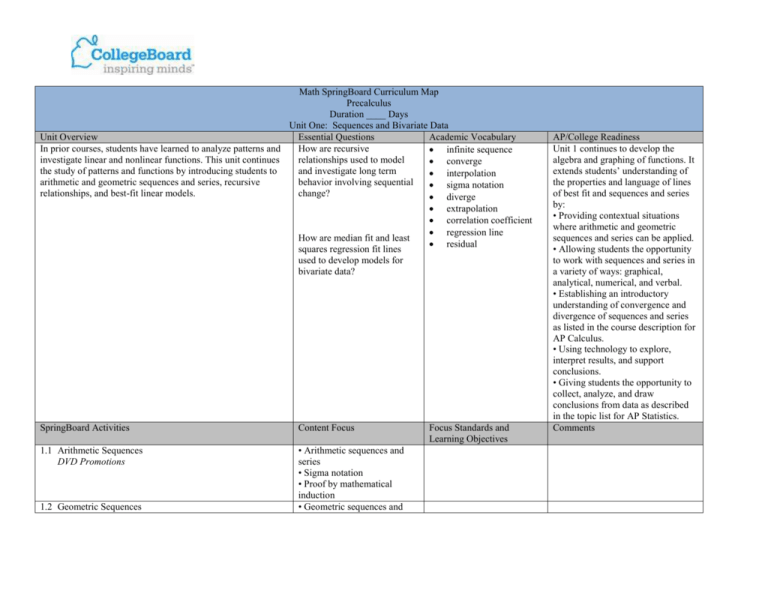
Math SpringBoard Curriculum Map Precalculus Duration ____ Days Unit One: Sequences and Bivariate Data Unit Overview Essential Questions Academic Vocabulary In prior courses, students have learned to analyze patterns and How are recursive infinite sequence investigate linear and nonlinear functions. This unit continues relationships used to model converge the study of patterns and functions by introducing students to and investigate long term interpolation arithmetic and geometric sequences and series, recursive behavior involving sequential sigma notation relationships, and best-fit linear models. change? diverge extrapolation correlation coefficient regression line How are median fit and least residual squares regression fit lines used to develop models for bivariate data? SpringBoard Activities Content Focus 1.1 Arithmetic Sequences DVD Promotions • Arithmetic sequences and series • Sigma notation • Proof by mathematical induction • Geometric sequences and 1.2 Geometric Sequences Focus Standards and Learning Objectives AP/College Readiness Unit 1 continues to develop the algebra and graphing of functions. It extends students’ understanding of the properties and language of lines of best fit and sequences and series by: • Providing contextual situations where arithmetic and geometric sequences and series can be applied. • Allowing students the opportunity to work with sequences and series in a variety of ways: graphical, analytical, numerical, and verbal. • Establishing an introductory understanding of convergence and divergence of sequences and series as listed in the course description for AP Calculus. • Using technology to explore, interpret results, and support conclusions. • Giving students the opportunity to collect, analyze, and draw conclusions from data as described in the topic list for AP Statistics. Comments She Sells Sea Shells 1.3 Modeling Recursive Relationships Money Market Accounts EA 1: Sequences The Old Square Craft 1.4 Median Fit Line Homework Help Line 1.5 Least-Squares Regression Lines The Mile Run 1.6 Linear Relationships Get Fit! EA 2: Linear Regressions and Predictions The Ice Cream Shoppe Assessment and Performance Opportunities Embedded Assessment 1 Embedded Assessment 2 Check Your Understanding series • Infinite geometric series • Sequences expressed recursively • Sequences expressed explicitly • Sequences expressed recursively • Sequences expressed explicitly • Median-median line • Estimate a trend line for scatter plot data • Construct a linear function to model data • Calculate sum of squared residuals • Regression line minimizes the sum of the squared residuals • Interpolate and extrapolate with linear models • Correlation coefficient • Appropriate use of linear regression • Residual plot • Bivariate outliers • Regression lines (medianmedian and least squares) • Sum of squared residuals • Outlier and the effect on the correlation coefficient Additional Resources Teacher Reflection Unit Practice Unit Reflection SB Online Unit Assessment In class questioning of students Monitoring of collaborative groups Unit Overview In prior units, students have studied arithmetic and geometric sequences and series, and modeling functions. In this unit students will review polynomial, rational, logarithmic, and exponential functions, and will work with functions and their transformations. Math SpringBoard Curriculum Map Precalculus Duration ____ Days Unit Two: Functions and their Graphs Essential Questions Academic Vocabulary How are zeros and end relative maximum behavior of polynomial multiple root functions and their graphs relative minimum related to the degree and the even function factors of the polynomial? odd function oblique asymptote natural logarithm How are logarithmic and exponential functions used to model real-world problems? SpringBoard Activities Content Focus 2.1 Polynomials Sunspots • Polynomial functions • Relative maximum • Relative minimum • x- and y-intercepts • End behavior • Graphing polynomial functions without a calculator • Fundamental Theorem of Algebra 2.2 Graphing Polynomial Functions Graph It Focus Standards and Learning Objectives AP/College Readiness Unit 2 expands on students’ understanding of multiple functions and makes connections between them by: • Providing contextual situations dealing with polynomial, rational, logarithmic, and exponential functions, as required in the prerequisite topic list for AP Calculus. • Giving students the opportunity to look at these functions graphically, numerically, algebraically, and verbally, both in and out of contextual situations. • Further developing the understanding of local extrema, and methods and tools that will be used at the calculus level to find them. • Beginning to look at the concepts of a limit at infinity Comments 2.3 Complex Polynomial Roots and Inequalities Open Question EA 1: Polynomial Functions Coffee Time 2.4 Rational Functions Playing Catch-Up 2.5 Rational Functions Rationalizing Water Collection EA 2: Rational Functions Taneytown Reunion 2.6 Exponential Functions Pennsylvania Lottery • Linear Factorization Theorem • Rational Root Theorem • Descartes’ Rule of Signs • Factor Theorem • Remainder Theorem • Creating a polynomial from its factors • Complex Conjugate Theorem • Complex factors of a polynomial • Solving a polynomial inequality • Modeling polynomial functions • Key features of polynomial functions • Graphs of polynomial functions • Rational functions R(x) =(ax+b)/(cx+d) • Domain and range of a rational function • Evaluation of rational functions using function notation • Vertical asymptote • Horizontal asymptote • Transformations of rational functions • Horizontal and vertical asymptotes • Holes • Slant asymptotes • Rational functions in context • Graphing rational functions • Compound interest • Exponential functions 2.7 Logarithms Power Trip 2.8 Transformations of Functions I Doubt It 2.9 Effects of Transformations Fore! EA 3: Transformed Functions Electric Wind Assessment and Performance Opportunities Embedded Assessment 1 Embedded Assessment 2 Embedded Assessment 3 Check Your Understanding Unit Practice Unit Reflection SB Online Unit Assessment In class questioning of students Monitoring of collaborative groups • Formulas and the effects of parameters •e • Common logarithm • Natural logarithm • Properties of logarithms • Change of Base Formula • Expanding expressions • Solving exponential and logarithmic equations • Transformations of functions • Even and odd functions • Operations on functions • Composition of functions • Characteristics of data sets • Transforming bivariate data • Straightening scatterplots and linearizing data using transformations • Exponential functions • Logarithmic functions • Logarithmic re-expression • Linear regression • Solving logarithmic equations • Transformation of functions Additional Resources Teacher Reflection Unit Overview In this unit students extend their previous knowledge of right triangle trigonometry in order to define the six trigonometric functions in terms of a point on a terminal side of an angle in standard position. The unit circle is developed along with the graphs of the trigonometric functions. The inverse trigonometric functions are defined and applied to the solving of simple trigonometric equations. Math SpringBoard Curriculum Map Precalculus Duration ____ Days Unit Three: Trigonometric Functions Essential Questions Academic Vocabulary What type of real-world amplitude problems are modeled and angle in standard solved using trigonometry? position trigonometric function inverse trigonometric function How are graphic periodic function representations of radian trigonometric functions unit circle useful in understanding real-life phenomena? SpringBoard Activities Content Focus 3.1 Angles and Angle Measure What's My Angle Measure? • Angles in standard position Focus Standards and Learning Objectives AP/College Readiness Unit 3 continues to prepare students for AP/College Readiness as they explore trigonometric and inverse trigonometric functions by: • Providing a contextual situation which develops the sine function. • Providing opportunities to study the six trigonometric functions and their inverse functions, including concepts such as: domain and range, odd and even, and period, all of which are included in the prerequisites for AP Calculus. • Giving students the opportunity to learn the values of trigonometric functions at the numbers 0, π/6, π/4, π/3, , π/2, and their multiples, a concept included in the prerequisites for AP Calculus. • Giving students opportunities to work with functions graphically, numerically, analytically, and verbally. • Providing opportunities for the appropriate use of technology to solve problems, experiment, interpret results, and support conclusions. Comments 3.2 Sinusoidal Functions Bicycle Wheels 3.3 Trigonometric Functions and the Unit Circle Wheels Revisited 3.4 Graphs of the form y = A sin[B (x ? C)] + D Trigonometric Graphs 3.5 Graphs of Other Trigonometric Functions More Trig Graphs EA 1: Angles, Unit Circle, and Trigonometric Graphs Orbiting Spacecraft • Coterminal angles • Radian measure • Converting between degree and radian measure • Reference triangles and right triangle trigonometry review • Introduction to sinusoidal functions • Periodic functions • Amplitude • Definitions of the trigonometric functions in terms of a point on the terminal side of an angle in standard position • Unit circle • Exact values of trigonometric functions for special angles • Graphing functions of the form y = A sin [B(x - c)] + D and y = A cos [B(x - c)] + D • Writing equations for sinusoidal curves • Graphing cosecant, secant, tangent, and cotangent functions • Sinusoidal models • Graphing trigonometric functions • Coterminal angles • Converting between degree and radian measure • Finding trigonometric values for angles on the unit circle • Solving for trigonometric values using the definition of the trigonometric functions in 3.6 Inverse Trigonometric Functions Viewing Angle 3.7 Solving Simple Trigonometric Equations Daylight Minutes EA 2: Inverse Trig Functions and Equations Show What You Know Assessment and Performance Opportunities Embedded Assessment 1 Embedded Assessment 2 Check Your Understanding Unit Practice Unit Reflection SB Online Unit Assessment In class questioning of students Monitoring of collaborative groups terms of a point on the terminal side of an angle in standard position • Definitions of inverse trigonometric functions • Graphs of inverse trigonometric functions • Solving simple trigonometric equations on a given interval • Finding general solutions for simple trigonometric equations • Reference angles • Graphing inverse trigonometric functions • Evaluating inverse trigonometric functions • Solving simple trigonometric equations Additional Resources Teacher Reflection Math SpringBoard Curriculum Map Precalculus Duration ____ Days Unit Four: Analytic Trigonometry and Trigonometric Applications Unit Overview Essential Questions Academic Vocabulary Unit 4 focuses on analytic trigonometry. Students learn How are algebraic and trigonometric identity fundamental identities, verify identities, evaluate expressions, geometric concepts related Law of Sines and solve equations. They solve a variety of problems using to trigonometric identities angle of elevation / right-triangle trigonometry, the Law of Cosines and the Law of and formulas? depression Sines. Ultimately, students learn that trigonometric ambiguous case (SSA) relationships are useful tools for performing calculations, Law of Cosines solving problems, and modeling real-world phenomena. How is trigonometry used to solve real world problems involving measure? SpringBoard Activities Content Focus 4.1 Trigonometric Identities Imagine That • Trigonometric Identities • Pythagorean Identities • Simplifying Expressions • Verifying Identities • Symmetry Identities • Cofunction Identities 4.2 Identities and Equations Triangle Measure Focus Standards and Learning Objectives AP/College Readiness Unit 4 builds upon what students learned in the previous unit by focusing on algebraic applications of trigonometric functions, equations and expressions. A thorough knowledge of trigonometric functions is a prerequisite skill for Advanced Placement Calculus. Unit 4 enhances this knowledge by: • Building facility with the algebraic manipulation of trigonometric functions and equations. • Preparing students to apply fundamental trigonometric identities in a variety of situations. • Writing equations from verbal and physical descriptions including the limiting behavior of n-sided polygons inscribed in a circle. • Emphasizing written and verbal communication by requiring students to justify their thinking about mathematical relationships. • Using technology as a tool to verify thinking and solve problems. Comments 4.3 Multiple Angle Identities Sounds Like Trigonometry EA 1: Trigonometric Identities and Equations Identify This, Solve That 4.4 Area of Triangles Where Has Polly Gone? 4.5 Law of Cosines The Chocolate Factory 4.6 The Law of Sines Lost? EA 2: Right and Oblique Triangles, Area Tilting Towers and Triangles Assessment and Performance Opportunities Embedded Assessment 1 Embedded Assessment 2 • Trigonometric Equations with Identities • Sum and Difference Identities • Double Angle Identities • Half Angle Identities • Verifying Identities with Multiple Angle Identities • Solving Equations with Multiple Angle Identities • Trigonometric Expressions, Identities and Equations • Simplifying, Evaluating, Verifying and Solving • Right Triangle Trigonometry Applications • Area of Triangle Using Trigonometry • Heron’s Formula • Modeling with Trigonometric Functions • Relationship Between Circular and Linear Motion • Unit circle definitions of sine and cosine and identities • The Law of Cosines • Right Triangle Trigonometry Applications • Area of Triangle Using Trigonometry • Heron’s Formula • Solving problems in context • Solving right and oblique triangles • Finding the area of a triangle Additional Resources Teacher Reflection Check Your Understanding Unit Practice Unit Reflection SB Online Unit Assessment In class questioning of students Monitoring of collaborative groups Math SpringBoard Curriculum Map Precalculus Duration ____ Days Unit Five: Conic Sections, Polar Coordinates, and Complex Numbers Unit Overview Essential Questions Academic Vocabulary In prior units, students have learned to analyze patterns, graph How are multiple polar coordinate functions, verify identities and solve multi-step equations. This representations of conic conic section unit continues the study of graphs by introducing students to sections related and used to graph of a polar conic sections and polar coordinates and graphs. model real world situations? equation polar form of a complex number How are polar and rectangular graphing related? SpringBoard Activities Content Focus 5.1 Parabola Equations and Graphs The Human Cannon Ball • Standard form of a Parabola • General form of a Parabola • Focus • Directrix • Construction of an ellipse from the locus definition • Standard and general form of the equation of an ellipse • Construction of a hyperbola 5.2 Ellipses and Hyperbolas Radio Navigation Focus Standards and Learning Objectives AP/College Readiness Unit 5 continues to develop the concept of graphs and extends students’ understanding of properties and language of conic sections and polar graphs by: • Giving students the opportunity to analyze the graphs of planar curves as described in the course description of AP Calculus. • Providing contextual situations where the graphs of conic sections and polar curves can be applied to solve problems. • Allowing students to communicate mathematics and explain solutions both verbally and in written form. • Modeling a written description of a physical situation with a planar curve. • Using technology to explore, interpret results, and support conclusions. Comments 5.3 Circles and Degenerate Conics Crop Circles EA 1: Equations of Conic Sections Design of Conic Sections 5.4 Polar Graphs Air Traffic Controller 5.5 Polar Curves and Polar Conics Roses, Rings, and Hearts from the locus definition • Standard and general form of the equation of a hyperbola • Using a hyperbola to model a real world situation • Equation of a circle • Degenerate conics • General form of a conic • Determining the equation of an ellipse from given information and determining the foci. • Rewriting the equation of a parabola in standard form and identifying the vertex, directrix, focus and axis of symmetry. • Writing the equation of a circle given the center and radius. • Determining the equation of a hyperbola from given information and determining the foci. • Points on the polar grid • Relationships between rectangular coordinates and polar coordinates • Graphs and rectangular form for polar curves r = a cos(θ) or r = a sin(θ) • Relationships between rectangular equations and polar equations. • Graphs of polar Rose, Cardioid and Limaçon curves with and without a graphing calculator. • Polar equations of conic 5.6 DeMoivre's Theorem The Power of Complex Numbers EA 2: Polar and Rectangular Coordinates Totally Polar Bees Assessment and Performance Opportunities Embedded Assessment 1 Embedded Assessment 2 Check Your Understanding Unit Practice Unit Reflection SB Online Unit Assessment In class questioning of students Monitoring of collaborative groups sections. • Complex numbers in rectangular and polar forms • Operations on complex numbers, algebraically and geometrically • Absolute value of a complex number • Argument of a complex number • De Moivre’s Theorem • Euler’s Identity and Euler’s Formula Additional Resources Teacher Reflection Math SpringBoard Curriculum Map Precalculus Duration ____ Days Unit Six: Vectors, Parametric Equations, and Motion Unit Overview Essential Questions Academic Vocabulary Unit 6 focuses on motion and how to model it mathematically How are parametric equations parametric equation with both parametric equations and vector representations. This and vectors used to solve rectilinear/planar unit builds on prior knowledge from all of the previous units as real world problems involving motion students create rich models and solve problems involving motion? vector linear, quadratic and circular motion. Vector concepts are cross product applied in both two and three dimensions as students learn to dot product model physical quantities that have both a magnitude and a three-dimensional direction. What are the advantages coordinate system and disadvantages to using Cartesian and parametric coordinate systems for graphing and solving problems? SpringBoard Activities Content Focus 6.1 Parametric Equations Ships in the Fog • Parametric equations • Relationship between parametric and non-parametric functions • Linear and rectilinear Motion • Parametric equations 6.2 Introduction to Vectors Moving Walkways Focus Standards and Learning Objectives AP/College Readiness Simply stated, calculus is the study of change and accumulation. This unit focuses on motion and how to represent it mathematically. In this unit, students acquire critical prerequisite skills by: • Modeling motion using both parametric equations and vectors as specified in the Calculus BC syllabus. • Making the connections between verbal, numerical, algebraic and graphical representations of relations and functions explicit to students. • Writing equations for motion from physical and verbal models and representing motion in the coordinate plane. • Communicating their understanding and justifying their thinking verbally and in writing. • Using technology to explore relationships, test conjectures, and refine algebraic models for solving complicated problems. Comments 6.3 Vectors in Two and Three Dimensions The Robotic Arm 6.4 Parametric Equations Revisited Keep Your Eye on the Ball EA 1: Parametric Equations and Vectors A Pirate's Life Assessment and Performance Opportunities Embedded Assessment 1 Check Your Understanding Unit Practice Unit Reflection SB Online Unit Assessment In class questioning of students Monitoring of collaborative groups • Vectors in 1- and 2dimensions • Vector addition and scalar multiplication • Vectors in 2- and 3dimensions • Vector operations • Representing fi gures in 3-dimensions • Dot and cross products of vectors • Modeling motion with parametric equations • Non-linear parametric equations • Using parametric equations to model situations and solve problems • Using vectors to model situations and solve problems • Representing geometric figures in a 3-dimensional coordinate system • Operations with vectors Additional Resources Teacher Reflection Math SpringBoard Curriculum Map Precalculus Duration ____ Days Unit Seven: Foundations for Calculus Unit Overview Essential Questions Academic Vocabulary In prior units, students have studied sequences and explored the How is the concept of limit limit characteristics of many types of functions, including applied in mathematics to continuous trigonometric and rational functions. In this unit, students will function discontinuities? discontinuous extend their study of sequences to include their related functions. In addition, students will continue to examine characteristics of functions, specifi cally end behavior and possible discontinuities, to develop an understanding of limits Why are limits important in and their connection to the continuity of a function. the study of end behavior? SpringBoard Activities Content Focus 7.1 Modeling Functions Bungee Jumping • Trigonometric functions/ harmonic motion • Exponential functions/damped harmonic motion, • Limit of a function at a point • One-sided limits • Limit of a sequence • Limits at infinity • Continuity of a function 7.2 Limits Close Enough 7.3 Limit of a Sequence and Limits at Infinity Reached Your Limit? 7.4 Continuity Focus Standards and Learning Objectives AP/College Readiness Unit 7 continues to develop the algebraic and graphical representations of functions and extends students’ understanding of the properties, graphs, algebra, and language of functions by: • Giving students opportunities to work with multiple representations of functions and to make connections between the representations. • Allowing students to communicate mathematics and explain solutions both verbally and in writing. • Using technology to help solve problems and support conclusions. • Modeling written descriptions of physical situations with functions. • Developing an intuitive understanding of the limiting process and of continuity. Comments • Intermediate Value Theorem • Extreme Value Theorem Embedded Assessment 1: Limits and Continuity • Finding limits of a function Ready for Calculus at a particular point or at infinity by using graphs, tables or algebraic methods • Convergence and divergence of a sequence • Continuity of a function Assessment and Performance Opportunities Additional Resources Continuing On Embedded Assessment 1 Check Your Understanding Unit Practice Unit Reflection SB Online Unit Assessment In class questioning of students Monitoring of collaborative groups Teacher Reflection


